Design & Webmaster: Gary Pilling, Design Program: Serif WebPlus x8, Host: iPage
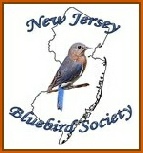

Their Natural History
The brilliant blue seven inch male Eastern Bluebird with his rusty throat, breast and sides and white belly sits high atop a dead tree or branch, TV antenna, or power line to hunt for the insects that make up two-thirds of his diet. He and his mate also eat wild berries, especially in cold weather when insects are not available. They rarely damage cultivated crops, and are very beneficial to farmers and gardeners.
Male 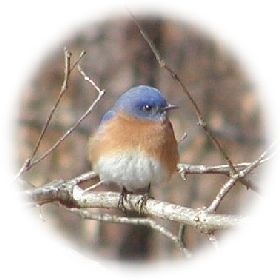 Eastern Bluebird in Winter
Eastern Bluebird in Winter
Photo by Ed Erkes
The young have spotted breasts until the fall molt when all bluebirds grow dull feathers for protection from predators. The males are bright blue again by spring.
As early as March or as late as June, the male bluebird locates a nesting site, establishes a territory around it, and sings to attract a female and warn other male bluebirds to stay away. Bluebirds are very territorial during nesting season and typically will not build within 100 yards of another bluebird nest.
Once a female accepts a site, she will do most of the nest building. She builds a neat cup nest of dry grasses or pine needles. Nest building may take five days to three weeks.
The female lays one blue (or rarely white) egg each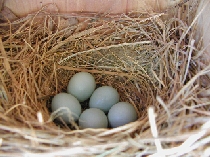 morning until three to six eggs are produced. Incubation begins after the last egg is laid. Thirteen to fourteen days later, after incubation, all will hatch within hours of each other. Five blue eggs in grass nest
morning until three to six eggs are produced. Incubation begins after the last egg is laid. Thirteen to fourteen days later, after incubation, all will hatch within hours of each other. Five blue eggs in grass nest
Photo by Liz Schmid
Hatchling before eyes have opened
Photo by Liz Schmid
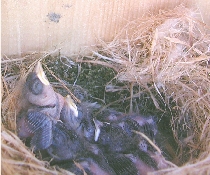
Both the male and the female adults tend to the nestlings. They feed the nestlings with soft insects graduating to coarser foods as the nestlings grow. Each nestling is fed about every 20 minutes.
The adults keep the nest clean by removing the fecal sacs which enclose the nestlings' waste. The young grow rapidly. Their eyes open on the eighth day.
The nestlings fledge, or leave the box, se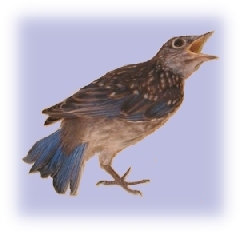 venteen to eighteen days after hatching. Usually the entire brood leaves the box within two hours. The fledglings can fly fifty to a hundred feet on their first flight and try to land in a bush, shrub, or low branches of trees to be off the ground and away from predators. The parents continue to care for the young and teach them how to catch their own food. The male will continue this job when the female begins her second or third nest.
venteen to eighteen days after hatching. Usually the entire brood leaves the box within two hours. The fledglings can fly fifty to a hundred feet on their first flight and try to land in a bush, shrub, or low branches of trees to be off the ground and away from predators. The parents continue to care for the young and teach them how to catch their own food. The male will continue this job when the female begins her second or third nest.
The spotted juvenile Eastern Bluebird
Photo by Liz Schmid
After the mating season is over, bluebirds give up their territories and flock together. North Carolina bluebirds do not migrate. They are joined by migrating northern bluebirds and roam the area looking for berries. The northern migrants usually move farther south after October. Bluebirds roost in pine tree stands and nesting cavities during cold weather.
“Thank you, North Carolina for use of this web page”.
© 2015 North Carolina Bluebird Society
| Please forward any comments or suggestions concerning this website to:
webadministrator@ncbluebird.org
About Bluebirds